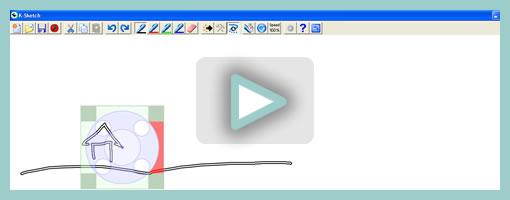K-Sketch
March 30th, 2010
K-Sketch, The Kinetic Sketch Pad is a pretty cool piece of software that came out of the Human-Computer Interaction and Design group from the University of Washington and is lead by Prof. Richard Davis. As the name indicates, the software allows to create quick sketches in time with a pretty simple and lightweight interface. Users can draw free form shapes and then transform those objects in a recording mode. The result is an animation composed of various objects that have their own animating paths.
I still haven’t tried out this tool on a real UI design project, but the concept is definitely inspirational and so I thought to share it. The K-Sketch project opens up the possibility and idea of sketching in the context of a timeline, which I think is quite novel in itself. If the desire of designers to express interactions seamlessly with the use of animation is strong enough (which I think it is), my guess is that we’ll be seeing more and more of functionality such as this in our prototyping tools of the future.
Download it and try it out yourself.
Here is another explanation straight off from their website:
K-Sketch allows ordinary computer users to create informal animations from sketches. Current tools for creating animation are extremely complex. This makes it difficult for designers to prototype animations and nearly impossible for novices to create them at all. Simple animation systems exist but severely restrict the types of motion that can be represented. To guide the design K-Sketch, we have conducted field studies into the needs of professional and novice animators. These studies showed the wide variety of motions that users desire in informal animations and indicate how to prioritize these types of motion. Our design allows the most important types of motion to be defined with pen gestures, and gives visual feedback for coordination of events.
Credits: Prof. Richard Davis
























April 2nd, 2010 at 6:55 pm
anything like this for Leopard?
May 16th, 2010 at 8:25 pm
This is cool. Although the comparative time to create animations over PowerPoint would have been more relevant if they had tested different users using each rather than the same user using PowerPoint first. They probably figured out things about how to think through making the animation in PowerPoint which would have inherently slowed that down, and created efficiencies when redoing the same animation in K-sketch.